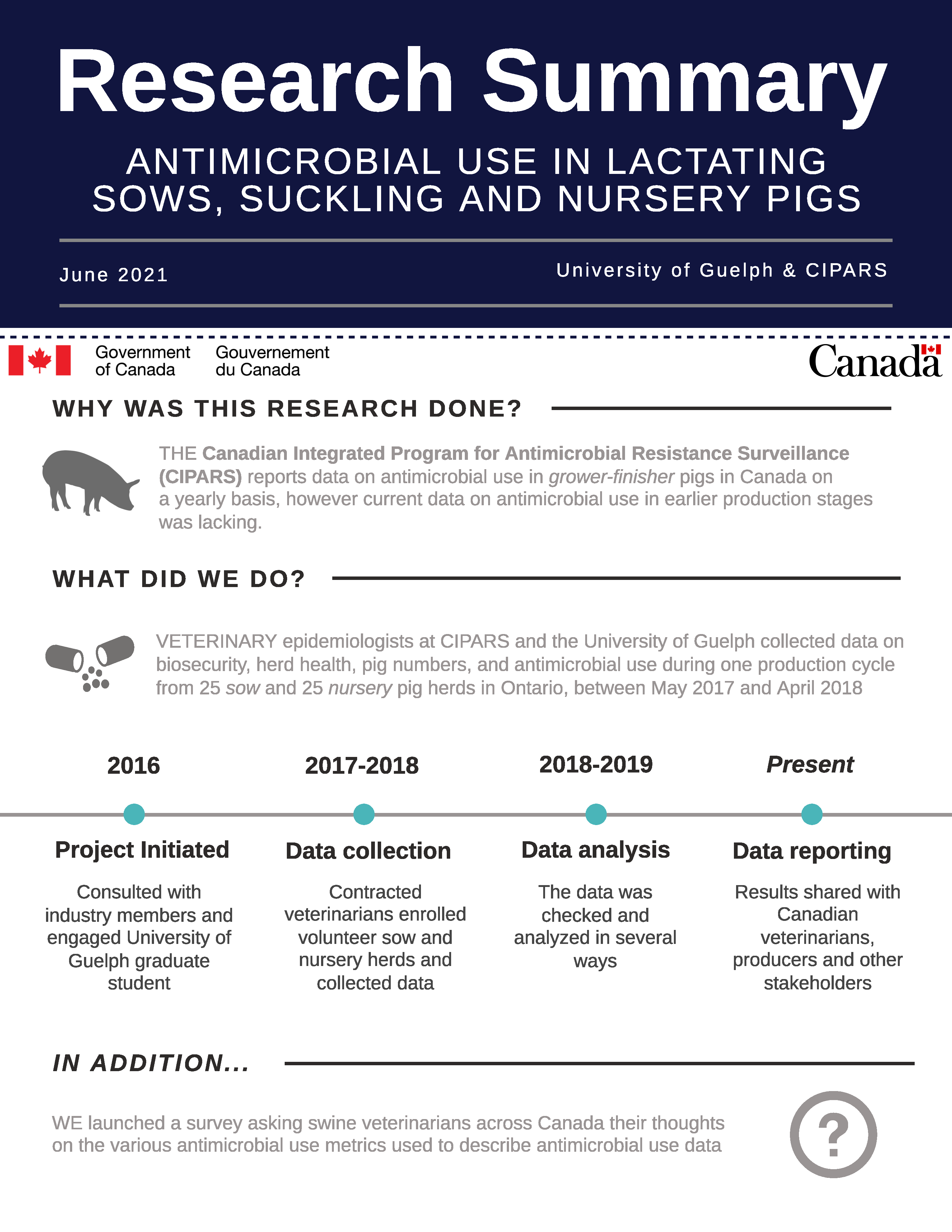Research summary: antimicrobial use in lactating sows, suckling and nursery pigs
Download in PDF format *OPTIONAL
(473 KB, 1 page)
Organization: Public Health Agency of Canada
Published: 2022-12-05
Why was this research done?
Canadian Integrated Program for Antimicrobial Resistance Surveillance (CIPARS) reports data on antimicrobial use in grower-finisher pigs in Canada on a yearly basis, however current Canadian data on the quantity of antimicrobial use (AMU) in sows and piglets was lacking.
What did we do?
Veterinary epidemiologists at the University of Guelph and CIPARS designed and carried out a research project examining the quantity of AMU during the farrowing and nursery stages of pig production. Data were collected during one production cycle from 25 sow and 25 nursery herds in Ontario, between May 2017 and April 2018. Additionally, we launched a survey asking swine veterinarians across Canada their thoughts on the various AMU metrics used to describe AMU data.
What did we find?
The number of sows per herd ranged from 100 to 1,600, and the capacity of the nursery pig barns ranged from 400 to 3,200 pigs. Four sow herds and two nursery herds were on a "Raised without Antibiotics" program. The use of most biosecurity practices was high among all herds, except for boot dips, which are often ineffective in barn environments. Forty percent of sow herds quarantined their new gilts prior to introduction to the main herd. Vaccination against major pig pathogens varied by pig type. All sows were vaccinated against Erysipelas, and the majority were vaccinated against Escherichia coli. Vaccination against Porcine Circovirus Associated Disease (PCVAD) and Mycoplasma was highest among nursery pigs. While some sows were vaccinated against influenza, no suckling pigs or nursery pigs received an influenza vaccination.
After adjusting for the dose of the antimicrobial used and the number of pigs at risk of receiving antimicrobials, nursery pigs received the highest total quantity of antimicrobials, followed by suckling pigs, and then sows (as measured by the number of Canadian defined daily doses per pig or nDDDvetCA per pig). The highest quantity of use was in feed. Only nursery pigs received antimicrobial in water. Suckling pigs received the highest quantity of antimicrobials by injection (as measured by nDDDvetCA per pig).
The top antimicrobials used in Canadian defined daily doses per 1,000 pig-days were:
- Lactating sows: bacitracin (in-feed) and procaine penicillin G (by injection)
- Suckling pigs: chlortetracycline (in creep feed) and benzathine penicillin G (by injection)
- Nursery pigs: chlortetracycline (in feed), procaine penicillin G (by injection) and amoxicillin (in water)
All creep feed offered was medicated with antimicrobials. During one production cycle 92% of herds gave antimicrobials to suckling pigs, 96% of herds gave antimicrobials to nursery pigs, and 92% of herds gave antimicrobials to lactating sows.
Two Health Canada Category I antimicrobials, considered very important to human medicine, were used. Ceftiofur was used for disease prevention in suckling pigs (990 nDDDvetCA/1,000 pig-days), and lactating sows (9 nDDDvetCA/1,000 pig-days). Ceftiofur was also used for disease treatment in suckling pigs (7 nDDDvetCA/1,000 pig-days). Enrofloxacin was used for disease treatment in nursery pigs (0.7 nDDDvet/1,000 pig-days) and lactating sows (4.3 nDDDvet/1,000 pig-days). It should be noted that the use of antimicrobials very important to human medicine for disease prevention purposes is contrary to WHO guidelines for antimicrobial use in food animals.
When Canadian swine veterinarians were surveyed, most preferred dose-based metrics (like defined daily doses for animals) over weight-based metrics (like milligrams per kilogram) and frequency measures (like percent rations medicated and days medicated). The top three factors affecting swine veterinarian's preferences for metrics are:
- The ability to detect changes in use on client's farms
- The ability to make comparisons in use with like-minded farms and other regions
- The ability to account for the dose of the antimicrobial
Canadian swine veterinarians felt comfortable having conversations with clients involving frequency measures and weight-based metrics; however, their comfort with conversations involving dose-based metrics could be improved.
How antimicrobial use is described
Antimicrobial use is described using frequency and quantitative measure. Examples of frequency measures include the number or percentage of farms or herds using antimicrobial, the number or percentage of rations medicated with antimicrobials, and the number or percentage of pigs in the herd exposed to antimicrobials. Examples of quantitative measure include weight- based measures such as the total kilograms of antimicrobial used or milligrams of antimicrobial used per kilogram of pig, and dose-based measures such as the number of Canadian defined daily doses per pig or the number of Canadian defined daily doses per 1,000 pig-days. Note that the number of doses in 1 kg of antimicrobial A does not necessarily equal the number of doses in 1 kg of antimicrobial B. Adjusting for differences in doses among the antimicrobials used helps us to better understand changes in antimicrobial use over time and differences in antimicrobial use between farms, and helps us to more accurately assess exposure to antimicrobials.
For more information please send an email to: cipars-picra@phac-aspc.gc.ca.
